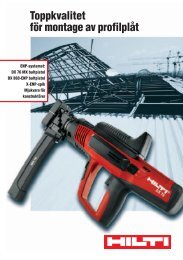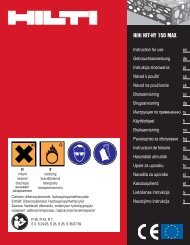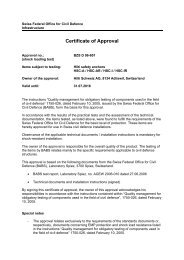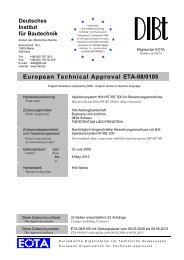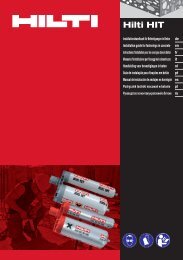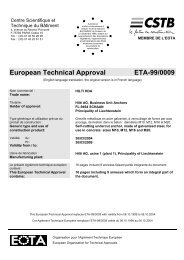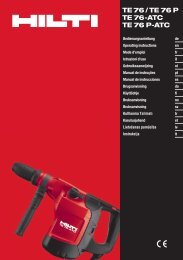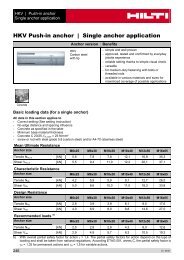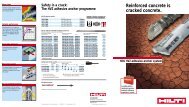00 Contents - Hilti Svenska AB
00 Contents - Hilti Svenska AB
00 Contents - Hilti Svenska AB
You also want an ePaper? Increase the reach of your titles
YUMPU automatically turns print PDFs into web optimized ePapers that Google loves.
The direct fastening system<br />
layer on fasteners driven into steel is, in fact,<br />
a disadvantage in that it reduces pull-out<br />
resistance. For this reason, the thickness of<br />
zinc on the fastener must be optimized to<br />
ensure good corrosion protection as well as<br />
high holding power. During production, tight<br />
control of the galvanizing process is necessary<br />
to prevent excess zinc thickness and<br />
thereby poor fastening performance.<br />
Fasteners must be 2 to 3 times harder than<br />
the material into which they are driven. The<br />
tensile strength of structural steel is com-<br />
monly between 4<strong>00</strong> and 6<strong>00</strong> MPa. Fasteners<br />
for use on steel thus require a strength of<br />
approximately 2<strong>00</strong>0 MPa. As Rockwell hardness<br />
is much easier to measure than<br />
strength, but good correlation exists<br />
between hardness and strength, this characteristic<br />
is used as a parameter in the<br />
specification and manufacturing of the fasteners.<br />
In the table below, HRC hardness is<br />
given for a range of tensile strengths (DIN<br />
50150).<br />
Tensile strength<br />
(MPa) 770 865 965 1810 1920 1995 2070 2180<br />
HRC 20.5 25.5 30 52.5 54 55 56.5 58<br />
2.2 Manufacturing process<br />
Standard hardened steel<br />
fasteners<br />
Almost all powder and gas-actuated fasteners<br />
used throughout the world are manufactured<br />
from carbon steel wire which is subsequently<br />
thermally hardened to provide the<br />
strength needed for driving into steel and<br />
concrete. In nail manufacturing, shank diameter<br />
is determined by the wire diameter<br />
used. Threaded studs are made from wire<br />
corresponding to the required thread diameter.<br />
The manufacturing process, which is<br />
summarized in the diagram below, consists<br />
of cutting the wire to length, shaping the<br />
head, knurling, forging or thermo pulling the<br />
point, hardening, galvanizing and assembling<br />
with washers.<br />
The process of hardening the steel to more<br />
than HRC 50 combined with the zinc plating<br />
presents a risk of hydrogen embrittlement.<br />
This risk is mitigated by heat treating the galvanized<br />
product at the optimum temperature<br />
for the correct time. Galvanized and heattreated<br />
fasteners are subjected to impact<br />
bending tests to check the effectiveness of<br />
the process. Depending on their intended<br />
application, some fasteners are additionally<br />
sampled and tested under tension and shear.<br />
Manufacturing Process<br />
Standard Zinc Coated Fasteners<br />
Cutting to length and head forming<br />
↓<br />
(Knurling)<br />
↓<br />
Point forging or thermo pulling<br />
↓<br />
Thermal hardening<br />
↓<br />
Galvanizing<br />
↓<br />
Heat treatment<br />
↓<br />
Assembly with washers<br />
1.12 11 / 2<strong>00</strong>7





